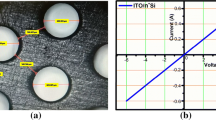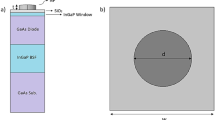Abstract
In this research work, a systematic design of a novel anti-reflective layer using embedded plasmonic nanoparticles is investigated for a thin-film GaAs solar cell. First, an anti-reflective layer that is made from ITO or SiO2 is assumed in which Al nanoparticles are embedded inside them to manipulate the absorption and hence the photocurrent of a 500-nm GaAs solar cell. It is investigated that the Al nanoparticles embedded inside the anti-reflective coating improve the photocurrent of a GaAs solar cell. For instance, the 15.37 mA photocurrent is obtained for 500-nm bare GaAs cell, and it reached to 17.25 mA/cm2 and 20.18 mA/cm2 when an ITO anti-reflection is used with Al nanoparticles on top and inside that, respectively. It increases to 21.94 mA/cm2 and 24.98 mA/cm2 in the case of the anti-reflective layer made from SiO2 and Al nanoparticles at the top side or inside that, respectively. Finally, using a double anti-reflective layer that is made from SiO2-TiO2, the maximum photocurrents of 23.79 mA/cm2 and 24.68 mA /cm2 are obtained when Al nanoparticles are at the top side or inside that, respectively. The simulation results show that the embedding Al nanoparticles in the anti-reflective layer can improve the photocurrent of a thin-film GaAs solar cell.







Similar content being viewed by others
References
Hosenuzzaman M, Rahim NA, Selvaraj J, Hasanuzzaman M, Malek AA, Nahar A (2015) Global prospects, progress, policies, and environmental impact of solar photovoltaic power generation. Renew Sust Energ Rev 41:284–297
Singh GK (2013) Solar power generation by PV (photovoltaic) technology: a review. Energy. 53:1–13
Kamat PV (2007) Meeting the clean energy demand: nanostructure architectures for solar energy conversion. J Phys Chem C 111(7):2834–2860
Heidarzadeh H, Rostami A, Dolatyari M (2020) Management of losses (thermalization-transmission) in the Si-QDs inside 3C–SiC to design an ultra-high-efficiency solar cell. Materials Science in Semiconductor Processing 109:104936
Heidarzadeh H (2019) Incident light management in a thin silicon solar cell using a two-dimensional grating according a Gaussian distribution. Solar Energy 189:457–463
Heidarzadeh H, Tavousi A (2019) Performance enhancement methods of an ultra-thin silicon solar cell using different shapes of back grating and angle of incidence light. Mater Sci Eng B 240:1–6
Heidarzadeh H, Rostami A, Matloub S, Dolatyari M, Rostami G (2015) Analysis of the light trapping effect on the performance of silicon-based solar cells: absorption enhancement. Appl Opt 54(12):3591–3601
Oh G, Kim Y, Lee SJ, Kim EK (2020) Broadband antireflective coatings for high efficiency InGaP/GaAs/InGaAsP/InGaAs multi-junction solar cells. Sol Energy Mater Sol Cells 207:110359
Bhatnagar A, Janyani V (2017) Cost effective and “high” power conversion efficiency ultra-thin film GaAs solar cell. Paper presented at: 2017 International Conference on Computer, Communications and Electronics (Comptelix)
Khatiwada D (2019) Fabrication and optimization of single-junction GaAs thin film solar cells on epi-ready flexible metal tapes for low-cost photovoltaics
Dey M, Rahman N, Tasnim I, Dey M, Das NK (2019) Design and numerical analysis of efficient gallium arsenide solar cell with graphene as window layer material. Paper presented at: 2019 International Conference on Electrical, Computer and Communication Engineering (ECCE)
Lin J-C, Ho W-J, Liu J-J, et al (2017) High-efficiency single-junction GaAs solar cell using ITO-film as an antireflection and passivation layer deposited on AlInP layer by thermally RF sputtering. Paper presented at: CLEO: QELS_Fundamental Science
Tang Q, Shen H, Yao H, Gao K, Jiang Y, Li Y, Liu Y, Zhang L, Ni Z, Wei Q (2019) Superiority of random inverted nanopyramid as efficient light trapping structure in ultrathin flexible c-Si solar cell. Renew Energy 133:883–892
Qiao F, Xie Y, He G, Chu H, Liu W, Chen Z (2020) Light trapping structures and plasmons synergistically enhance the photovoltaic performance of full-spectrum solar cells. Nanoscale
Jangjoy A, Bahador H, Heidarzadeh H (2019) Design of an ultra-thin silicon solar cell using localized surface plasmonic effects of embedded paired nanoparticles. Opt Commun 450:216–221
Mokari G, Heidarzadeh H (2019) Efficiency enhancement of an ultra-thin silicon solar cell using plasmonic coupled core-shell nanoparticles. Plasmonics. 14(5):1041–1049
Morawiec S, Crupi I (2020) Light trapping by plasmonic nanoparticles. Solar Cells and Light Management. Elsevier, pp 277–313
Heidarzadeh H, Mehrfar F (2018) Effect of size non-uniformity on performance of a plasmonic perovskite solar cell: an array of embedded plasmonic nanoparticles with the Gaussian distribution radiuses. Plasmonics. 13(6):2305–2312
Sobhani F, Heidarzadeh H, Bahador H (2020) Photocurrent improvement of an ultra-thin silicon solar cell using the localized surface plasmonic effect of clustering nanoparticles. Chinese Physics B 29(6):068401
Thongrattanasiri S, de Abajo FJG (2013) Optical field enhancement by strong plasmon interaction in graphene nanostructures. Phys Rev Lett 110(18):187401
Grady NK, Halas NJ, Nordlander P (2004) Influence of dielectric function properties on the optical response of plasmon resonant metallic nanoparticles. Chem Phys Lett 399(1–3):167–171
Akimov YA, Koh WS (2011) Design of plasmonic nanoparticles for efficient subwavelength light trapping in thin-film solar cells. Plasmonics. 6(1):155–161
Sobhani F, Heidarzadeh H, Bahador HJO, Electronics Q (2020) Efficiency enhancement of an ultra-thin film silicon solar cell using conical-shaped nanoparticles: similar to superposition (top, middle, and bottom) 52(9):1–13
Heidarzadeh H (2020) Analysis and simulation of a plasmonic biosensor for hemoglobin concentration detection using noble metal nano-particles resonances. Optics Communications 459:124940
Bahador H, Heidarzadeh H (2020) Analysis and simulation of a novel localized surface plasmonic highly sensitive refractive index sensor 1–7
Atwater HA, Polman A (2011) Plasmonics for improved photovoltaic devices. Materials for sustainable energy: a collection of peer-reviewed research and review articles from Nature Publishing Group: World Scientific 1–11
Ren W, Zhang G, Wu Y, Ding H, Shen Q, Zhang K, Li J, Pan N, Wang X (2011) Broadband absorption enhancement achieved by optical layer mediated plasmonic solar cell. Opt Express 19(27):26536–26550
Mallah AR, Zubir MNM, Alawi OA, Newaz KMS, Badry ABM (2019) Plasmonic nanofluids for high photothermal conversion efficiency in direct absorption solar collectors: fundamentals and applications. Sol Energy Mater Sol Cells 201:110084
Liu L, Wang W, Long J, Fu S, Liang Y, Fu J (2019) Three-dimensional plasmonic photoanode of Au nanoparticles/ZnFe2O4 nanosheets coated onto ZnO nanotube arrays for photoelectrochemical production of hydrogen. Sol Energy Mater Sol Cells 195:330–338
Yao G-Y, Zhao Z-Y, Liu Q-L, Dong X-D, Zhao Q-M (2020) Theoretical calculations for localized surface plasmon resonance effects of Cu/TiO2 nanosphere: generation, modulation, and application in photocatalysis. Sol Energy Mater Sol Cells 208:110385
Devi BP, Wu K-C, Pei Z (2011) Gold nanomesh induced surface plasmon for photocurrent enhancement in a polymer solar cell. Sol Energy Mater Sol Cells 95(8):2102–2106
Lin S-J, Lee K-C, Wu J-L, Wu J-Y (2012) Plasmon-enhanced photocurrent in dye-sensitized solar cells. Sol Energy 86(9):2600–2605
Li X, Hylton NP, Giannini V, Ekins-Daukes NJ, Maier SA (2014) Design guidelines for efficient plasmonic solar cells exploiting the trade-off between scattering and metallic absorption. arXiv preprint arXiv:1408.2603
Sarkın AS, Ekren N, Sağlam Ş (2020) A review of anti-reflection and self-cleaning coatings on photovoltaic panels. Sol Energy 199:63–73
Said SA, Al-Aqeeli N, Walwil HM (2015) The potential of using textured and anti-reflective coated glasses in minimizing dust fouling. Sol Energy 113:295–302
Heidarzadeh H, Rostami A, Dolatyari M, Rostami G (2016) Plasmon-enhanced performance of an ultrathin silicon solar cell using metal-semiconductor core-shell hemispherical nanoparticles and metallic back grating. Appl Opt 55(7):1779–1785
Author information
Authors and Affiliations
Corresponding author
Additional information
Publisher’s Note
Springer Nature remains neutral with regard to jurisdictional claims in published maps and institutional affiliations.
Rights and permissions
About this article
Cite this article
Jangjoy, A., Bahador, H. & Heidarzadeh, H. A Comparative Study of a Novel Anti-reflective Layer to Improve the Performance of a Thin-Film GaAs Solar Cell by Embedding Plasmonic Nanoparticles. Plasmonics 16, 395–401 (2021). https://doi.org/10.1007/s11468-020-01297-2
Received:
Accepted:
Published:
Issue Date:
DOI: https://doi.org/10.1007/s11468-020-01297-2




